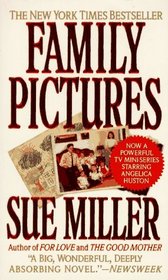Helpful Score: 4
Good, not as good as The Good Mother, but good. I recommend this to any family who has an autistic child in the family. It really shows how that impacts the family on a whole.
Helpful Score: 2
"Sue Miller can flat-out write, there is no doubt about that. Her prose is polished, smooth, and engrossing, incorporating fine cadence, descriptive language, and an unusual ability to capture skillfully some of the feelings or thoughts that she attributes to particular characters." amazon
Helpful Score: 2
Family Pictures is a book that doesn't let go. You may want to read it twice: the first time to allow yourself to be swept up in caring and aching for this family, then again to savor Sue Miller's words and grasp their full impact. The story is told through the eyes of four different family members, and the complexity of family relationships is brought home through the various ways different characters interpret and react to the same events. The catalyst for this family's dysfunction is an autistic child, and each family member deals with Randall's mute power in his or her own way. The psychiatrist father withdraws emotionally and physically, unable to bear his family's pain as he does his patients'. The mother manifests her love, guilt, and shame through compulsive achievements, from wallpapering to having three more "perfect" children to compensate for Randall. The children foray into rebellious acts of teens in the 1960s. Each character comes to realize with varying degrees of poignancy "that each child represents such risk, such blind daring on its parents' parts - such possibility for anguish and pain - that each one's existence was kind of a miracle." This warm, gritty, realistic tale is about such daring
Helpful Score: 2
Engrossing, sometimes heart wrenching, but excellent reading. I couldn,t put it down. GinaK
Helpful Score: 1
A large family attempts to deal with one memebers difference - autism - when autism was barely recognizable on the spectrum of disorders. The father was a psychiatrist, unable to heal his son and the mother, a stay at home mom, unable to provide the perfect looking family in 1950's America. Also, at that time Autism was commonly blamed on the mother who was considered too cold or sterile therefore de-emotionalizing the child. How did all this effect a large family - read and find out!!





